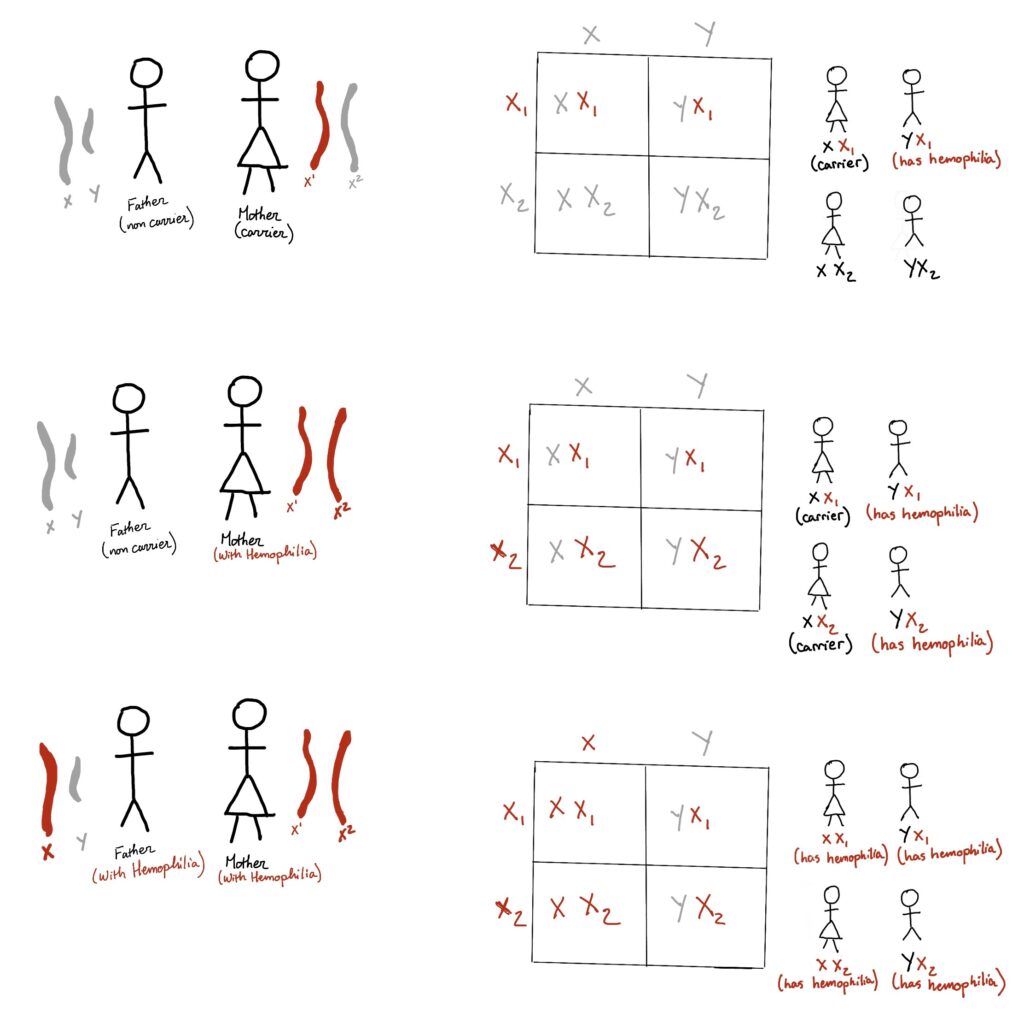Hemophilia is a genetic disorder, which impairs the body’s ability to produce clotting factors to staunch bleeding. People who suffer from hemophilia are at an increased risk of internal bleeding in the joints and brain. The two main types of hemophilia, hemophilia A and hemophilia B, are due to low amounts of clotting factor VIII and clotting factor IX respectively. Two more less common types of hemophilia are hemophilia C and Phrahaemohilia. Diagnosis for hemophilia is done by testing the blood for clotting factor levels and by testing the blood’s ability to clot.
Clotting factors are proteins in the blood that respond to a site of injury to staunch the flow of blood while the tissue regrows and remodels. The F8 gene is responsible for providing the code to synthesize clotting factor VIII and the F9 gene has the instructions for clotting factor IX. Mutations in either of these genes reduces the amount of their respective clotting factors which causes improper clot formation in response to injury. Depending on the severity, this can cause severe bleeding. In serious cases of hemophilia, even mild traumas can provoke extreme bleeding. Bleeding in the joints is very common in hemophilia patients and eventually breaks down the joint lining resulting in hemophilic arthropathy.
Hemophilia is an inherited genetic disorder that is caused by a mutation on the X-chromosome. The mutations that cause the disease are X-linked recessive and a female who carries the defective gene might not be expressing it. Because the Y-chromosome in males does not have a gene for clotting factor VIII or IX, if a male inherits a defective X-chromosome, he has a 50% chance of inheriting hemophilia from a mother who does not have hemophilia and a 100% chance of inheriting the condition from a mother who does have hemophilia. For a female to inherit the disease, she needs to inherit two defective X-chromosomes- one from a hemophilic father and one from a hemophilic mother. Because it is a genetic condition, the condition does have a chance of spontaneously mutating. Spontaneous mutations of hemophilia A make up about 33% of cases and about 30% of the cases of hemophilia B.
If there is a family history of hemophilia, genetic testing is recommended to people who are planning on having children to determine the risk of the parents passing down the condition. If there is no family history, diagnosis typically happens when a child becomes more mobile and might be experiencing joint bleeds or easy bruising. A blood test to identify clotting factors is done and it will also be able to identify which type of hemophilia a child has.
Currently the most common treatment for hemophilia is infusions of factor VIII or factor IX on a regular basis to prevent joint bleeds and the subsequent hemophilic arthropathy. This prophylaxis treatment is started when a patient, who has a known family history of hemophilia, is young- around the ages of one or two. Being able to decrease the risk of a patient bleeding into their joints decreases the risk of developing hemophilic arthropathy later on in life. There are several gene therapy trials taking place- one of which uses an adeno-associated viral vector that is designed to drive the expression of clotting factor IX. Though gene therapy is not currently a recognized treatment, study results have shown some promise. Gene therapy is a rapidly growing field and has opened up a lot of doors towards the treatment for other monogenic disorders.
Sources
Centers for Disease Control and Prevention. (2021, June 29). How hemophilia is inherited. Centers for Disease Control and Prevention. Retrieved April 14, 2022, from https://www.cdc.gov/ncbddd/hemophilia/inheritance-pattern.html#:~:text=It%20almost%20always%20is%20inherited,cells%20that%20contain%20the%20genes).
Coppola, A. (2010). Treatment of hemophilia: A review of current advances and ongoing issues. Journal of Blood Medicine, 183. https://doi.org/10.2147/jbm.s6885
Indiana Hemophilia and Thrombosis Center. (n.d.). Joint bleeds. Indiana Hemophilia & Thrombosis Center. Retrieved April 14, 2022, from https://www.ihtc.org/hemophilia-joint-bleeds#:~:text=Joint%20bleeds%20are%20the%20main,condition%20known%20as%20hemophilic%20arthropathy.
Joint bleeds. Indiana Hemophilia & Thrombosis Center. (n.d.). Retrieved April 14, 2022, from https://www.ihtc.org/hemophilia-joint-bleeds#:~:text=Joint%20bleeds%20are%20the%20main,condition%20known%20as%20hemophilic%20arthropathy.
Okaygoun, D., Oliveira, D. D., Soman, S., & Williams, R. (2021). Advances in the management of haemophilia: Emerging treatments and their mechanisms. Journal of Biomedical Science, 28(1). https://doi.org/10.1186/s12929-021-00760-4
U.S. National Library of Medicine. (2020, August 18). Hemophilia: Medlineplus genetics. MedlinePlus. Retrieved April 14, 2022, from https://medlineplus.gov/genetics/condition/hemophilia/


Julia has made us a drawing/ model to show us the way our chromosomes affect who will inherent hemophilia. Hemophilia is a genetic condition brought on by a mutation with the x chromosome. The mother is the main determining factor on weatherbor not a child will inherent the condition.
Hemophilia is a medical condition in which the ability of the blood to clot is severely reduced, causing the person to bleed severely from even a slight injury. The condition is typically caused by a hereditary lack of a coagulation factor, most often factor VIII. This means a mutation or change happens in one of the genes, that provides instructions for making the clotting factor proteins needed to form a blood clot. This change or mutation can prevent the clotting protein from working properly or to be missing altogether.
In Julia’s model above she shows the relationship of the x chromosome and the chances of the gene being passed on. It is almost always inherited (passed down) from a parent to a child. Both hemophilia A and B are inherited in the same way, because both the genes for factor VIII and factor IX are located on the X chromosome (chromosomes are structures within the body’s cells that contain the genes). Hemophilia is an disease, most commonly affecting males. Since males have only a single copy of any gene located on the X chromosome, they cannot offset damage to that gene with an additional copy as can females. Therfore males are more likely to inherent this disease.